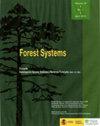两种墨西哥针叶树在高海拔地区形成幼林的干旱响应
IF 0.7
4区 农林科学
Q3 FORESTRY
引用次数: 6
摘要
研究目的:确定高海拔森林对季节性干旱的响应。研究领域:蒙特Tláloc、姆萨梅西科州和杜拉兹诺牧场、Río佛得州、圣路易斯Potosí、姆萨梅西科。材料与方法:本研究通过对比两种墨西哥针叶树的年轮生长记录和归一化植被指数(NDVI),评价了两种墨西哥针叶树对干旱和水文气候的响应。主要结果:结果表明,红松和冷杉易受冬春降水状况和温暖条件的影响。根据干旱胁迫的影响,不同物种的生理反应机制似乎有所不同。NDVI显示了不同物种对水文气候限制的不同生理响应。这种差异可归因于每个地区特定的自然和地理条件所存在的空间差异。干燥和温暖的季节气候表明,黄杨和黄杨是易受干旱条件影响的物种。然而,有必要进一步评估这些物种的抵抗力和复原力,以及解开可能影响灭绝或迁移预测过程的相关机制的影响。研究重点:红松和冷杉易受季节性干旱的影响。这些结果是特别重要的气候情景预测升高的过渡带。树木年轮宽度和NDVI改善了径向生长对气候的响应,增强了我们对森林生长动态的认识。对气候变化的反应取决于特定的物种。本文章由计算机程序翻译,如有差异,请以英文原文为准。
Drought responsiveness in two Mexican conifer species forming young stands at high elevations
Aim of study: To determine the response of high-altitudinal forests to seasonal drought. Area of study: Monte Tláloc, Estado de México and Rancho del Durazno, Municipality of Río Verde, San Luis Potosí, México. Materials and methods: In this study, we evaluate the response to drought and hydroclimate in two young Mexican conifers sampled at high elevation, correlating records of tree-ring growth and the Normalized Difference Vegetation Index (NDVI). Main results: The results show that Pinus teocote and Abies religiosa are vulnerable to the precipitation regime and warm conditions of winter-spring. The physiological response mechanisms seem to be differentiated between the species, according to the effects of drought stress. The NDVI demonstrated the different temporal responses of the species according to their inherent physiological mechanisms in response to hydroclimatic limitations. This differentiation can be attributed to the spatial variation present in the particular physical and geographic conditions of each area. The dry and warm seasonal climates reveal P. teocote and A. religiosa to be species that are vulnerable to drought conditions. However, further evaluation of the resistance and resilience of these species is necessary, as well as disentanglement of the effects of associated mechanisms that can influence the predicted processes of extinction or migration. Research highlights: Pinus teocote and Abies religiosa are vulnerable to the seasonal drought conditions. These results are of particular importance given the climatic scenarios predicted for elevated ecotones. Tree-ring widths and NDVI improved the response of radial growth to the climate, enhancing our understanding of forest growth dynamics. The response to climatic variability depends on the particular species.
求助全文
通过发布文献求助,成功后即可免费获取论文全文。
去求助
来源期刊

Forest Systems
FORESTRY-
CiteScore
1.40
自引率
14.30%
发文量
30
审稿时长
6-12 weeks
期刊介绍:
Forest Systems is an international peer-reviewed journal. The main aim of Forest Systems is to integrate multidisciplinary research with forest management in complex systems with different social and ecological background
 求助内容:
求助内容: 应助结果提醒方式:
应助结果提醒方式:


